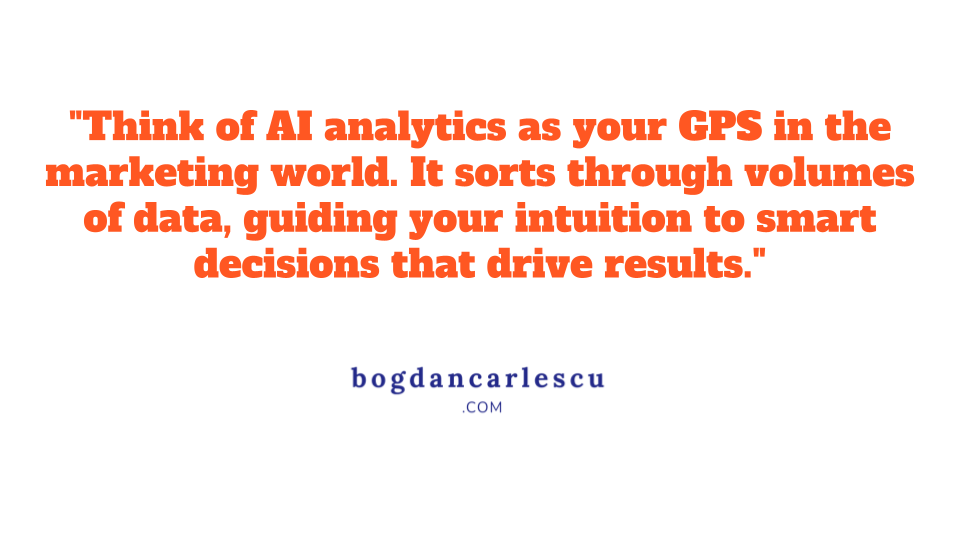Welcome back to my series on AI in the marketing technology landscape. In this post, I’m covering AI Analytics for marketing. Over the course of this journey, we’ve delved into the significant role AI plays in numerous areas, including advertising, content writing, and marketing automation. We also looked into some of the challenges brought by Generative AI.
This blog is on a particularly fascinating territory, one where machine learning and artificial intelligence intertwine with data analysis. Welcome to the world of AI-powered Analytics! I must say that natively I’m basing my decisions on intuition and gut feeling. Along the way, I also learned that data insights are very valuable for validating or invalidating my decisions. I spend a great deal of time making sense of data analytics and how I can leverage it best in my marketing profession. The post is the result of my own struggles and enlightenment.
Explore more
In the age where ‘data is the new oil’, our ability to navigate through vast amounts of information has become a critical business advantage (learned the hard way). But it’s not just about gathering this data. The real value lies in the extraction of actionable insights from this data, enabling us to make data-driven decisions that have a profound impact on our marketing strategies and, ultimately, on business success.
Coming as the evolution of “traditional” data analysis, Artificial Intelligence based Analytics is reshaping the marketing landscape, enabling businesses to discover valuable insights, predict future trends, and deliver a personalized, customer-centric experience like never before. It is worth mentioning that AI Analytics has many other use cases besides marketing. I dedicated an entire blog to AI-driven analytics applications in cybersecurity.
Understanding AI-powered Analytics
To truly appreciate the transformative potential, we first need to understand what it actually is. The term itself, AI Analytics, refers to the use of artificial intelligence and machine learning algorithms to analyze data and generate insights. But it’s more than just another tech buzzword. It represents a paradigm shift from traditional analytics to advanced, AI-powered methods.
In traditional analytics, data analysis is largely manual. A data analyst would sift through the data, look for patterns, and draw conclusions based on their findings. While this method has its merits, it’s inherently limited by human capacity. The volume of data we’re dealing with today is simply too vast for manual analysis. Plus, the speed at which data is generated means we need real-time insights to stay ahead.
This is where the new generation of Analytics comes in. Machine Learning (ML) algorithms can analyze massive amounts of data at lightning speed. More importantly, AI systems can learn from this data. They can recognize patterns, make predictions, and even generate recommendations – all in real-time. This level of analysis goes beyond what any human data analyst could achieve, providing us with insights that can drive more informed, effective decisions.
Here are some of the key components of AI Analytics:
- AI and Machine Learning: At the heart of AI Analytics are artificial intelligence and machine learning. These technologies enable the system to learn from data, adapt to new information, and improve over time. Throughout the blog I will use AI and ML interchangeably, though, strictly speaking, AI as a category includes ML.
- Big Data: AI Analytics thrives on vast amounts of data. The more data it has, the more accurate its predictions and insights will be.
- Predictive Analytics: This is one of the most powerful applications of AI Analytics. Using historical data, AI can make predictions about future behavior or trends. For marketers, this means predicting customer behavior, market trends, or the performance of a marketing campaign.
- Data Visualization: AI Analytics is not just about generating insights. It’s also about presenting these insights in a way that’s easy to understand. Data visualization tools can help transform complex data into visually appealing, easy-to-understand graphs and charts.
- Real-Time Insights: One of the biggest advantages of AI Analytics is its ability to provide real-time insights. As data is generated, AI can analyze it and provide immediate insights. This allows businesses to react quickly to changes, improving their agility and decision-making speed.
The combination of these elements makes Artificial Intelligence Analytics a powerful tool for businesses. By leveraging it, businesses can harness the power of their data, gain valuable insights, and make data-driven decisions that drive growth and improve customer experience.
The Role of AI Analytics in Marketing
The marketing and advertising world has been completely transformed by data. Every interaction a user has with a brand or product generates data, and this data holds valuable insights about the user’s preferences, behaviors, and needs. As marketers, it’s our job to understand and utilize these insights to deliver more effective, personalized marketing activities. That’s where AI Analytics comes in.
AI Analytics takes the massive amounts of data generated by our marketing efforts and turns it into actionable insights. Whether it’s analyzing customer data, predicting future trends, or optimizing marketing campaigns, AI Analytics is a powerful tool for marketers.
Analyzing Customer Data
One of the key aspects of AI in marketing is its ability to understand customers on a deep level. This understanding comes from interacting with customers (hopefully!) but also from data. One strong point of ML algorithms is to analyze data and identify patterns.
AI analytics tools can sift through vast amounts of customer data, identify patterns, and create detailed customer profiles. These profiles can tell us a lot about our customers – their preferences, their behavior, and their needs. This understanding enables us to create more personalized, relevant marketing that truly resonates with our audience.
Predictive Analytics
Predictive analytics is the second key feature of AI Analytics. Using historical data, AI can predict future behavior or trends. For marketers, this could mean predicting which products a customer might be interested in, which marketing channels will be most effective, or when a customer might be ready to make a purchase.
These predictions allow us to be proactive in our marketing efforts. Instead of reacting to customer behavior, we can anticipate it and create marketing strategies that meet customers exactly where they are.
Optimizing Marketing Campaigns
Remember when I talked about AI in advertising and how it’s changing the way we run and optimize ads? AI Analytics plays a big role in this. It can analyze campaign data in real time, provide insights into what’s working and what’s not, and make recommendations for optimization.
For instance, an AI analytics tool could analyze your email marketing campaign, determine the best time to send emails to each recipient, and even suggest subject lines that are likely to increase open rates. This level of optimization can significantly improve the effectiveness of your marketing campaigns and boost your marketing ROI.
Customer Segmentation
In my blog on AI for marketing automation, I wrote about how AI can improve customer segmentation. Well, AI Analytics is a crucial part of that. It can analyze customer data and segment customers based on various factors such as behavior, preferences, and purchase history.
With these detailed customer segments, we can create personalized marketing campaigns that speak directly to each customer’s needs and interests. This not only increases engagement but also improves the overall customer experience.
The use of AI Analytics in marketing is vast and varied. But, irrespective of how you use it, the goal is the same – to understand our customers better, create more effective marketing campaigns, and improve our outcomes. Now, let’s take a look at some of the tools available to us and how to choose the right one for our needs.

AI Analytics Tools
Just as there are countless ways to use AI Analytics in marketing, there are also countless AI tools available to us. These tools vary in their features and capabilities, but they all aim to help us make sense of our data and turn it into actionable insights. Here are a few key AI analytics tools that you might find beneficial:
Google Analytics
Google Analytics, a favorite among data analysts (especially Universal analytics), provides a suite of AI-powered analytics capabilities. Its predictive analytics features allow marketers to understand current user behavior and predict future actions like churn or purchase likelihood. These predictions, based on vast amounts of historical data, can help marketers craft more informed strategies.
Tableau
Tableau is renowned for its data visualization capabilities, turning complex datasets into understandable visuals. It also has AI-powered features that provide advanced analytics, including predictive modeling and trend analyses. Personally, I found it difficult to work with Tableau, but many others found it very valuable.
IBM Watson
IBM Watson (the new generation was renamed Watsonx) brings the power of AI to business analytics. This is a massive and massively capable product. It can analyze massive amounts of data, uncovering patterns and relationships that help professionals in many domains, marketing included. With Watson, you can make data-driven decisions faster and with more confidence.
Adobe Analytics
Adobe’s analytics solution, as part of its Adobe Experience Cloud, leverages AI to deliver real-time analytics and detailed segmentation. Its predictive analytics capabilities allow marketers to forecast future trends and customer behaviors. Adobe Analytics works particularly well when coupled with Adobe’s infrastructure solutions for web services.
Salesforce Einstein
Part of the Salesforce CRM platform, Einstein is a set of AI technologies that provide advanced analytics. It helps businesses predict sales and customer behavior, making it easier to strategize and optimize marketing efforts.
These are only a few of the available tools, many others exist. Choosing the right AI analytics tool comes down to understanding your specific needs and objectives. You might require a tool with strong predictive analytics capabilities, or maybe data visualization is a priority for you. Or perhaps you need a tool that seamlessly integrates with your existing CRM or marketing automation platform. Keep these factors in mind as you evaluate different AI analytics tools.
One important consideration is the compatibility of these tools with your existing systems and workflows. As we discussed in the blog about AI-powered marketing automation, seamless integration is key to ensuring that the AI tool enhances, rather than disrupts, your existing processes. With the right tool and the right approach, AI analytics can significantly enhance your marketing outcomes.
Implementing AI Analytics in Marketing
Let’s discuss how to implement these powerful technologies into your marketing efforts. Remember, the goal here is to enhance your marketing strategy with valuable insights derived from AI-powered data analysis, not to complicate your existing processes. Here are some practical steps to guide your implementation:
1. Define Clear Objectives
Begin by identifying your specific goals for your AI implementation. What insights are you looking to gain? How will these insights improve your marketing efforts? Having clear objectives will help guide your AI Analytics strategy and ensure that your efforts are targeted and effective.
2. Identify Relevant Data Sources
AI Analytics thrives on data and the quality of the outputs depends on the quality of the data. Therefore, it’s crucial to identify the data sources that will be most useful to your objectives. This could be customer data, website analytics, social media data, sales data, etc. Ensure that the data source is reliable and that you have the necessary permissions to use them.
3. Choose the Right AI Analytics Tool
As we discussed earlier, there are many AI Analytics tools available, each with its own strengths and capabilities. Select the tool that best aligns with your objectives and fits seamlessly into your existing workflows.
4. Train and Test your AI Tool
Once you’ve chosen a tool, you’ll need to train your AI model using your selected data sources. This involves feeding your AI system with data, allowing it to learn patterns and relationships. Be prepared for this to be an iterative process. You’ll likely need to train and test your model multiple times before it’s ready for deployment.
5. Monitor and Optimize
After implementing your new AI tool, continue to monitor its performance and make adjustments as necessary. Remember, AI Analytics is a dynamic process that requires continuous learning and adaptation.
AI Analytics is a powerful addition to any marketing toolkit, but it’s not a magic wand. It requires careful planning, implementation, and ongoing management. However, with the right approach, AI Analytics can provide valuable insights that help you better understand your customers, optimize your marketing strategies, and ultimately deliver a superior customer experience.
The Future of AI Analytics in Marketing
So far, we’ve scratched the surface of AI Analytics and its potential for transforming the way we do marketing. But what does the future hold? As with other facets of AI in martech, the future is exciting, promising, and a bit unpredictable. Here are some trends to watch:
1. Advanced Predictive Models
As AI algorithms and machine learning models continue to improve, we can expect even more accurate predictive analytics. Imagine being able to predict a customer’s behavior, preferences, and even their decision-making process with near-perfect accuracy. This would revolutionize marketing strategy, making it more personalized and effective than ever before.
2. Greater Integration with other Martech Tools
As I’ve mentioned in my previous post on AI in advertising, AI for marketing automation, and AI for content writing, the power of AI is not just in its standalone capabilities but also in its potential for integration. In the future, expect to see AI Analytics tools becoming more seamlessly integrated with other martech tools, providing a more comprehensive and holistic view of the customer journey.
3. More User-friendly AI Tools
Currently, many AI Analytics tools require a certain level of expertise to use effectively, often requiring the skills of data scientists. However, as these tools evolve, they’re likely to become more user-friendly, enabling even those without a technical background to harness the power of AI in their marketing efforts. ChatGPT was a breakthrough from this perspective. It generated an unprecedented amount of user adoption partly because of its easy-to-use interface.
4. Improved Data Visualization
One of the challenges of AI Analytics is making sense of the vast amounts of data it generates. In the future, expect to see advances in data visualization, making it easier to interpret and understand the insights generated by AI.
5. Ethical Considerations
As AI continues to play a larger role in marketing and other areas of business, ethical considerations will become increasingly important. Issues like data privacy, transparency, and fairness will need to be carefully managed to maintain trust and respect in the era of AI.
As we look toward the future of AI Analytics in marketing, the potential is truly exciting (and frightening as I often say it). The advancements in this field will no doubt continue to reshape the marketing landscape, driving more efficient, personalized, and impactful marketing strategies. It’s a future that we, as marketers, need to be ready for. Stay curious, stay informed, and most importantly, stay adaptable. AI is not just the future of marketing – it’s the present.
Conclusion
The transformative potential of AI Analytics in marketing is no longer a thing of the future; it’s already reshaping how we approach and understand our customers. By leveraging AI-powered tools, we can analyze and derive insights from vast amounts of data, giving us a level of understanding that traditional analytics simply cannot match. The result is a more personalized, effective, and impactful marketing strategy that truly resonates with our customers.
Throughout this post, I’ve dived into the world of AI Analytics, exploring how it works, the benefits it offers, some of the key tools available, and its potential future. We’ve also seen how AI Analytics can supercharge our marketing efforts, especially when it comes to customer segmentation and personalized marketing.
Here are the key takeaways from this blog:
-
- AI Analytics is transforming how we approach marketing, providing us with deeper insights and more accurate predictions.
- AI-powered tools can analyze and learn from vast amounts of data, going beyond traditional analytics.
- Customer segmentation can be greatly enhanced with AI, allowing for more personalized marketing strategies.
- There are a number of AI Analytics tools available, each with its own strengths and use cases.
- The future of AI Analytics in marketing is bright, with advances in predictive models, greater integration, improved data visualization, and more.
As we continue to navigate the AI landscape in marketing, it’s clear that the journey is just beginning. As I’ve stated in my previous posts in this series, integrating AI into marketing is an ongoing process of learning and adaptation. It’s a thrilling journey that’s shaping not only the future of marketing but also the present.




